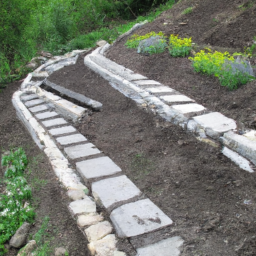How To Build A Tiered Garden On A Slope
Table of Contents []
How To Build A Tiered Garden On A Slope
Introduction
Do you have a slope in your garden that you don't know what to do with? Look no further. Building a tiered garden on a slope is an easy and attractive way to make it more useable. From a single garden bed to several, and from a single block of plants to an abundance, the possibilities for your tiered garden on a slope are endless. Whether you're a seasoned gardener or have never tried it before, here are some topics you should learn about to build a tiered garden on a slope.
Building Materials
The type of materials you use to build a tiered garden on a slope is key to its success. There are organic materials such as wood and soil, and man-made materials such as concrete blocks and plastic edging. It is important to consider the materials in terms of not only the look you are going for, but also practicality and safety. For example, wooden walls may be decorative but could rot over time, while metal edging may be more durable but may rust.
Constructing The Garden
The next step in tiered garden construction on a slope is to construct the actual garden, including the walls, steps, and beds. For this, you'll need the appropriate tools and materials. You may need to excavate the area and level the soil, install retaining walls, lay pavers for steps and pathways, and build individual beds.
Landscaping
Once you have constructed your tiered garden on a slope, it is time to start planting and landscaping. This involves choosing plants that will work best on a slope, where soil may be shallow and drainage not ideal. Consider native plants that will naturally thrive and not require a lot of maintenance. Decide on spacing for planting and think about adding features such as water features, arbors, and walkways for added interest.
Mulching
Mulching is a material placed over the soil to help anchor and retain moisture, reduce weeds, and keep the soil temperature steady. Organic mulches such as bark, straw, or compost can break down over time and add nutrients to the soil, while inorganic mulches such as gravel or stones don't break down but still work to prevent erosion.
Irrigation
When building a tiered garden on a slope, irrigation is a necessity to ensure plants receive the water they need. This can be done manually using a hose or watering can, or with an in-ground irrigation system if it's a large area. When installing an irrigation system, be sure to consider the slope and drainage of the area.
Pests
Unfortunately, no matter how well you design your tiered garden on a slope, you will likely encounter some pests. Ants, slugs, snails, aphids, and other pests can wreak havoc on your garden. To minimize damage, be sure to clean up garden debris, check plants regularly, and use natural pest control methods such as garlic or neem oil sprays.
Maintenance
Maintaining a tiered garden on a slope will require regular work such as weeding, mulching, pruning, and fertilizing. It's also a good idea to regularly check drainage, especially after rain or watering, as this can cause runoff on a slope. Finally, don't forget to inspect your retaining walls and other structures regularly for any weak spots or damage.
Summary
Building a tiered garden on a slope is a great way to make the most of an unusable area and add an attractive feature to your landscape. The key is to choose the right materials for construction and landscaping, and to maintain it regularly. With a little planning and work, your tiered garden on a slope can be beautiful and provide many years of enjoyment.

Previous Page
Next Page
